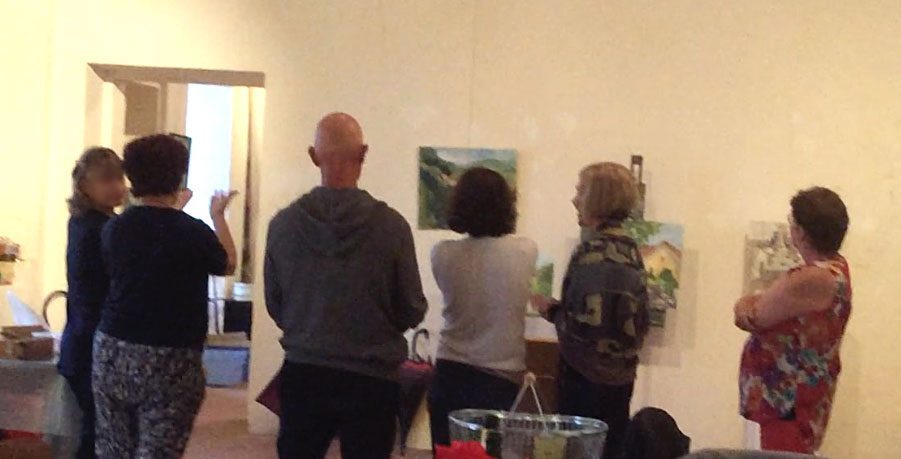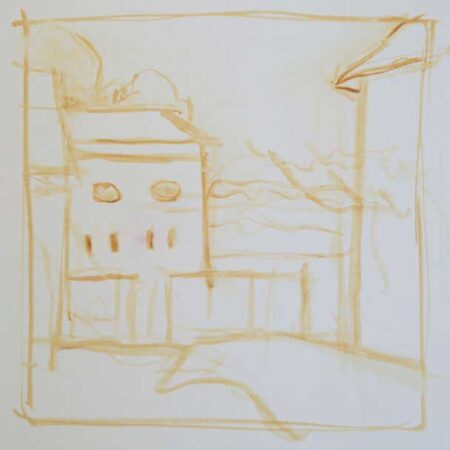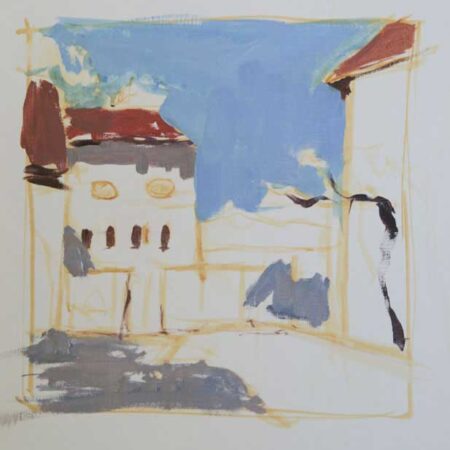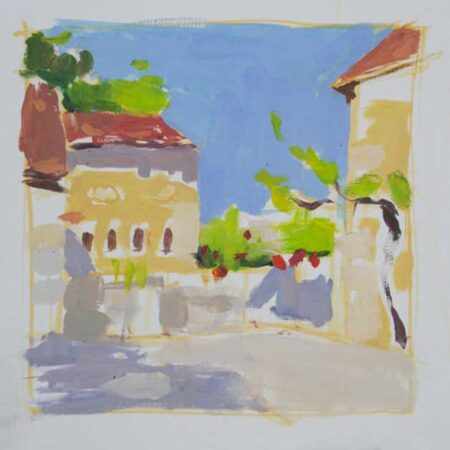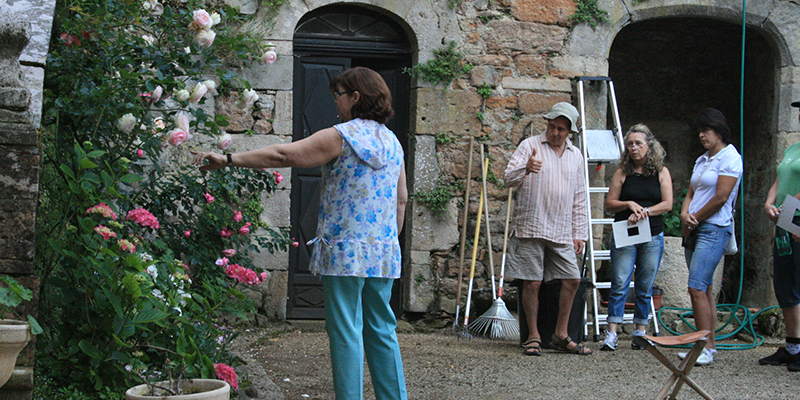
By Adam Cope. B.A.hons; Further Education & Adults Teachers Cert; Foundation Diploma Art Therapy.
This is a good question, and doubtless this is also what every potential student asks herself before she commits to enrolling with a tutor, who she doesn’t know! I ask myself this question also, and I think that the answer has two parts to it… 1. the teacher and 2. the artist.
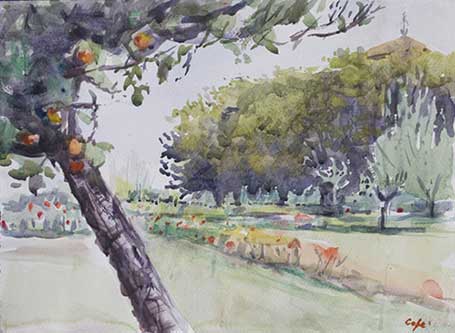
The finished painting ‘Apple Tree and Château’, September 2013, by Adam Cope

1. The teacher should be an experienced art teacher. And ideally, should have a teaching qualification.
Teaching is an art in itself. A subtle art that isn’t quickly mastered. It doesn’t follow that if you like an artist’s work, then she will be a good teacher. A well run class depends on the tutor’s teaching skills. It will run smoothly, without any fumbling around and without leaving you asking ‘what do I do next?’
But it’s not just about teaching skills. There’s also a cluster of character traits that you should look out for as well. Here’s some of them :
– Lots of enthusiasm, dedication, patience & humour. Above all, the desire that you’ll learn whilst you ‘enjoy the ride.’ Painting isn’t easy… laughter & fun helps.
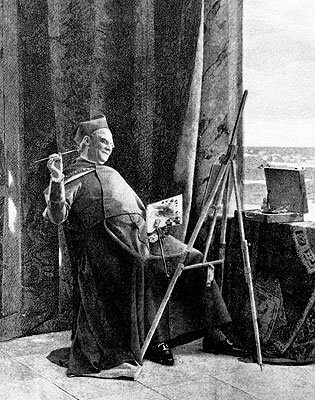
Beware! Abandon all hope of amusement! Go no further!
Vibert, The Science of Painting (1892)
We are about to teach!
– Sensitive to your individual aspirations & learning needs i.e. doesn’t impose a ‘one style suits all.’ Have a look at the student’s paintings gallery to see if there’s diversity. But remember that, on a plein-air painting workshop, you aren’t going to find too many Tracy Emins!
– Good listening skills.
– Not too many axes to grind. Not too many biases. Not too much desire to show off & boast. Not on an ego trip… i.e. is genuinely concerned about your learning needs.
– At your service i.e. dedicated.
– Should never pass judgment in a way that will hurt. We learn by making mistakes, and then detecting them. This is how one painting is born out of the other previous painting. Criticism should help development by pinpointing weak areas & not undermining confidence.
– Deep respect for creativity.
“Poetry arrived in search of me. I don’t know, I don’t know where it came from, from winter or from a river. I don’ know how or when... “Poetry arrived in search of me. I don’t know, I don’t know where it came from, from winter or from a river. I don’ know how or when...
– Pablo Neruda
– Nurtures that magical spark in you. We learn best by doing, supported by reflection afterwards. A good learning environment encourages you to experiment.
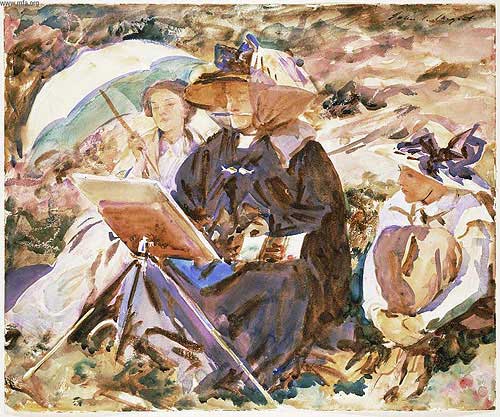
Art may seem to be in danger of being drowned by talk… We have neglected the gift of comprehending things through our senses. Concept is divorced from percept, and thought moves among abstractions.”
– Arnhiem. Art and Visual Perception, a Psychology of the Creative Eye
2. The tutor is also a practicing artist. Their paintings should inspire you.
Much of painting is a story about how one painter relates to the paintings of other painters.
I used to share a studio with a professional picture restorer. Watching him work (& asking for explanations about painting techniques) was just fabulous. I couldn’t have learnt this from a ‘how to paint’ book.
A good painting workshop tutor instructs you step-by-step in the techniques of painting, in an easy to follow & practical way.
I hear & I forget
Chinese Proverb
I see & I remember
I do & I understand
Clarity is a hard won virtue. Do you need a long confusing answer to a simple question?
A good tutor should give good painting demonstrations.

Demonstration – How to Begin an Oil Painting with a Colour Lay-In
There are many ways to begin an oil painting. Here, I show how to paint a ‘block in’, where the major colours are ‘laid-in’ early on.
- STEP ONE : Score-in, with Yellow Ocre thinned with spirits.
- STEP TWO : Block-in, start with the sky, then the roofs, next add the shadows.
- STE THREE : Continue with the sunlit areas. Calibrate the major blocks of colour. Next, add the accent colour (the red geraniums).
The advantage of starting with a block-in is that all the major color relationships are established early on. Thus the quality of light and colour are laid down right from the beginning. Note that the shadows are included early on. Once you have laid down the major blocks of colour in the correct relationship & a sense of light in the painting begins, then you are free afterwards to work up details & develop the painting. One of the challenges here in the south of France is how exactly do you paint the intensely red geraniums against a blue, blue, blue sky?
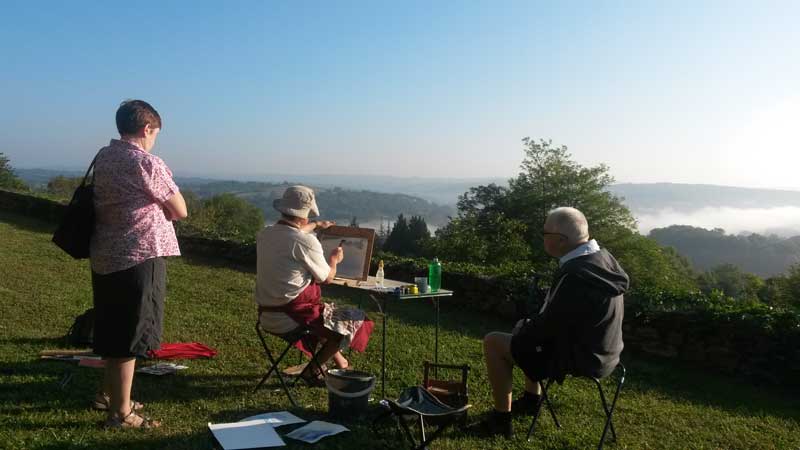
” A picture is worth a thousand words and watching a picture being painted is worth even more….The best teachers I’ve had show you rather than tell you how to do something. Talking the talk is far less important than walking the walk.
– Charles Sovek
The tutor should have a whiff of turpentine about him. Painting is first & foremost an activity, not a theory. The demonstrations will be more natural because the painter-teacher has hard-won working knowledge. A hand & an eye that has been trained. The guidance more relevant because he has been there too.
” When teaching, you must constantly engage in self-examination of your beliefs and working methods. It is not possible, nor is it fair to your group, to try and bluff your way through any difficult questions.
– Robert Wade
A good workshop tutor should know the landscape, the colours & the stories of the region. This intimacy will guide you in a way that a tutor from outside, simply can not.
Mentoring
A good mentor listens deeply to your learning needs. Talking & investigating together, ‘sur la vif’, in front of the subject is one of the best ways that the practice of painting is handed down. Books can never replace personal input.
If you teach the individual, find out where they are having trouble and help at that point.
– Irwin Greenberg
I believe that every artist must work hard at developing her style… every day if possible. And thus must have a commitment to life-long learning. We never stop learning. Painting is a humbling business & we must be prepared to learn from our mistakes. Even if these mistakes hurt, they teach us what how we don’t want to paint.

